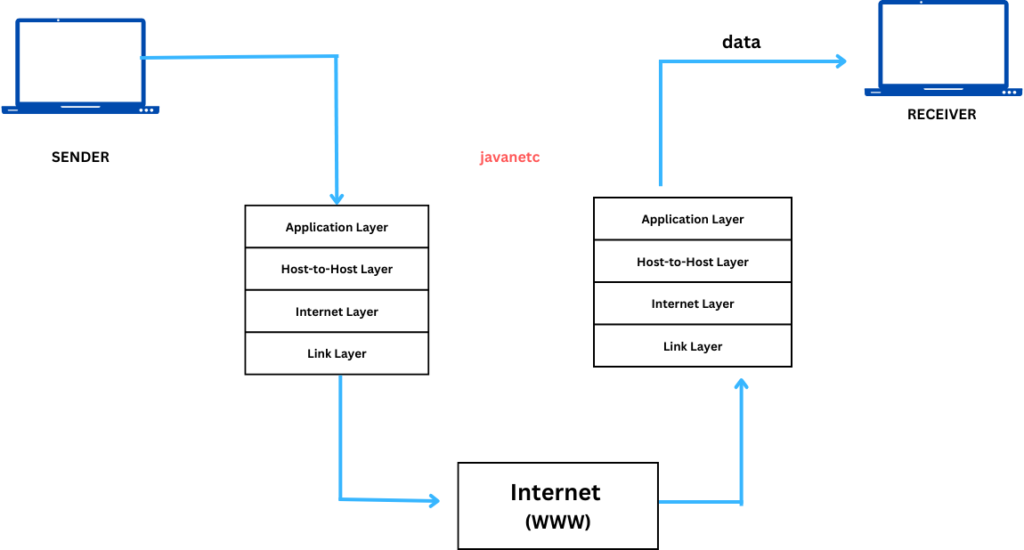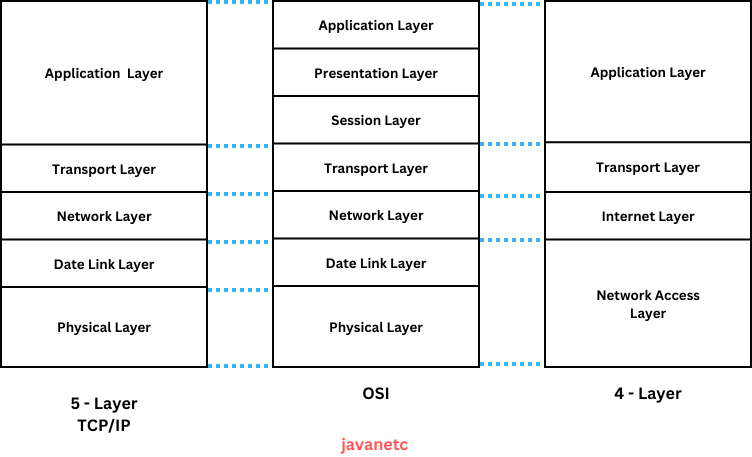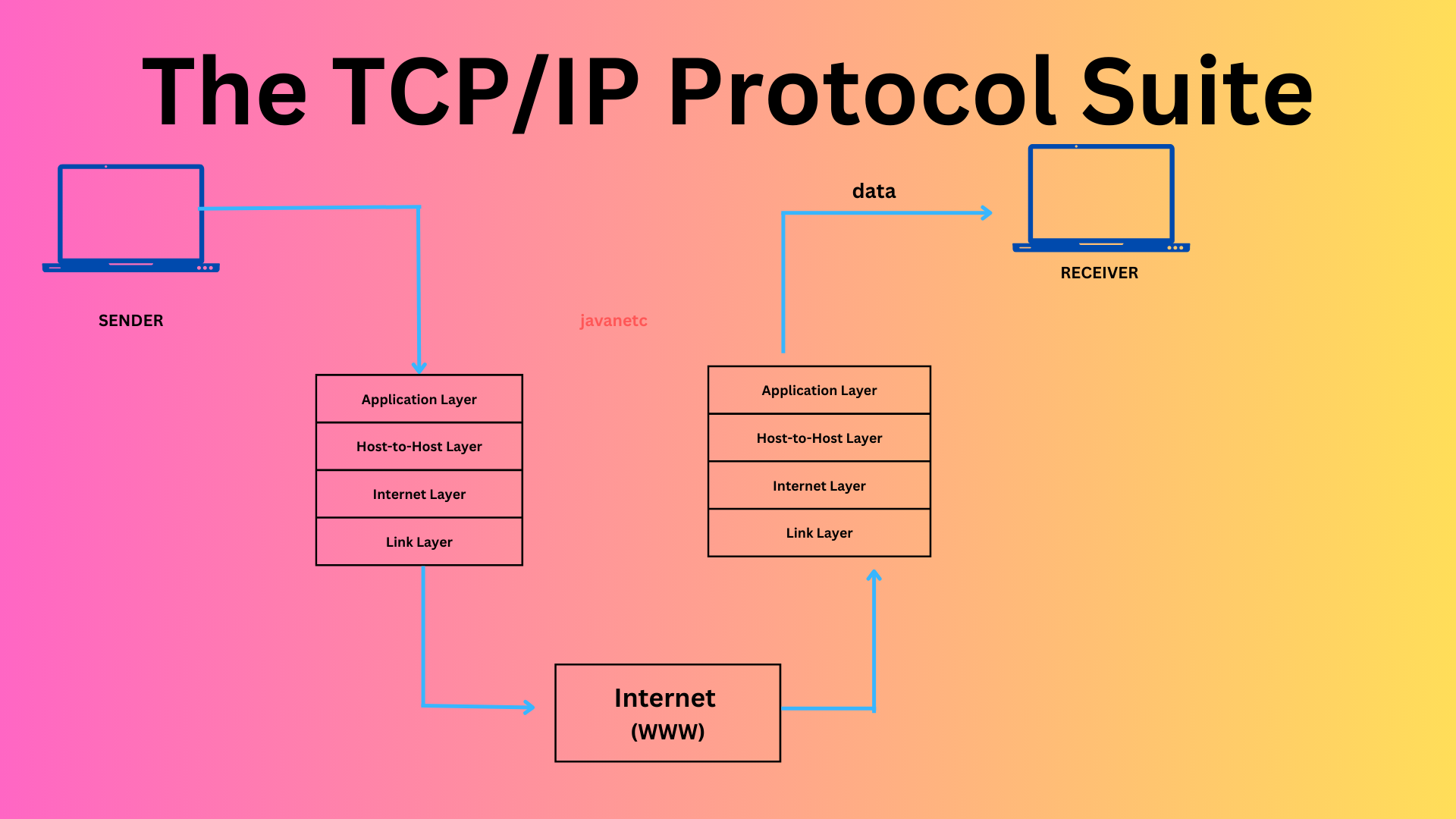Introduction
TCP/IP, short for Transmission Control Protocol/Internet Protocol, is a set of communication protocols facilitating data exchange between devices. It governs packetization, addressing, transmission, routing, and reception of data over a network, ensuring end-to-end communication. Unlike the OSI model, which is theoretical, TCP/IP is practical and widely applied.
Originally developed by DARPA (Defense Advanced Research Projects Agency) in the 1970s, TCP/IP was initially one of several internet protocols. It gained prominence as the standard for ARPAnet, the precursor to the modern internet, and has since become the global standard for internet communication.
Table of Contents
What is TCP/IP Model?
The TCP/IP model facilitates long-distance communication between devices and governs how data is transmitted over the internet. It outlines protocols for packetization, addressing, transmission, routing, and reception, ensuring seamless end-to-end communication. Comprising four layers—application, transport, network, and data link—each layer has specific responsibilities according to the protocols.

In comparison to the OSI model, TCP manages communication channels establishment and message segmentation into data packets for transmission and reassembly at the destination. IP, on the other hand, determines packet addressing and routing to ensure delivery. Gateways on the network use IP addresses to forward messages to their destinations.
Key Points:
- TCP/IP enables communication between distant devices.
- TCP governs data flow and error handling, while IP assigns unique addresses to network devices.
How Does the TCP/IP Protocol Work?
The TCP/IP model operates by dividing data, such as text messages, files, or video messages, into packets within its four-layered architecture. These packets travel from sender to receiver, following a sequential order, and are reassembled at the destination.

TCP/IP utilizes the client-server communication model, where a client (a user’s computer) sends service requests to a server (such as a web hosting provider) for tasks like fetching web pages. It also employs point-to-point communication, transmitting data between host computers within a network boundary. Each client request is independent and unrelated to previous ones, making TCP/IP stateless and enabling indefinite use of network channels.
Standardization is crucial for effective communication, and TCP/IP ensures this by providing both efficiency and uniformity. As the global standard, it ensures reliable internet data transmission, contributing significantly to fast and efficient internet services.
Key Points:
- TCP/IP divides data into packets based on its four-layered architecture.
- Standardization within the TCP/IP model ensures efficiency and reliability in internet data transmission.
- The TCP/IP model’s global standardization is instrumental in maintaining fast and effective internet services.
Layers in TCP/IP Model
The TCP/IP model primarily comprises four essential layers:
- Application Layer
- Host-to-Host Layer/Transport Layer
- Internet Layer/Network Layer
- Network Access Layer/Link Layer

However, to meet specific client requirements efficiently, TCP/IP can be further categorized into a five-layer model, where the data link layer and physical layer are separated from the Link layer. This adjustment allows for greater flexibility and optimization.
The article will concentrate on the four-layer TCP/IP model and explore each layer’s functions and significance within the TCP/IP architecture.
Four layers of the TCP/IP protocol suite:
The TCP/IP protocol suite consists of four layers, each serving distinct functions:
1. Application Layer:
This layer combines the functionalities of the OSI model’s top three layers (Application, Presentation, and Session). It facilitates node-to-node communication and governs user-interface specifications. Protocols such as HTTP, SMTP, TELNET, and FTP operate at this layer. For instance, HTTP enables access to internet data, SMTP handles email transfer, and TELNET establishes remote connections between computers.
2. Host-to-Host/Transport Layer:
Comparable to the OSI Transport layer, this layer manages how much data should be sent, when, and at what rate. It ensures timely and error-free delivery of messages received from the application layer. Key protocols include:
- Transmission Control Protocol (TCP): Known for reliable, error-free communication between end systems, TCP segments data, manages sequencing, and employs flow control mechanisms. Despite its effectiveness, TCP incurs higher overhead due to its features like acknowledgment and flow control.
- User Datagram Protocol (UDP): A connectionless protocol suitable for applications not requiring guaranteed transmission. UDP lacks reliability features, making it more cost-effective than TCP.
3. Internet Layer:
Also known as the Network layer, it focuses on forwarding packets from source to destination, irrespective of their route. This layer, responsible for sending variable-length data sequences across networks, doesn’t guarantee reliable message delivery. Notable protocols include:
- Internet Protocol (IP): Manages packet delivery based on IP addresses in packet headers, supporting both IPv4 and IPv6.
- Address Resolution Protocol (ARP): Resolves IP-to-hardware address conflicts, converting between 32-bit IP addresses and 48-bit MAC addresses.
4. Network Access Layer/Link Layer:
Handling physical data transmission over the network, this layer facilitates communication between adjacent devices on the same network. It determines how bits are transmitted via network media such as coaxial, optical, or twisted-pair cables.
Highlights:
- The Application Layer governs node-to-node communication and user-interface specifications, hosting essential protocols like HTTP and SMTP.
- The Host-to-Host Layer regulates data transmission rates and methods, featuring TCP for reliability and UDP for cost-effectiveness.
- The Internet Layer forwards packets to their destinations regardless of the route, managed by IP and ARP protocols.
- The Network Access Layer manages physical data transmission between adjacent network devices.
Uses Of TCP/IP Model:
Enabling Internet Communication: TCP/IP provides a suite of communication protocols facilitating data exchange between devices, thereby making the internet accessible and functional.
Text Communication:
Services like WhatsApp, Instagram, Google Chat, and iMessage rely on TCP/IP for ensuring error-free and ordered transmission of text messages, vital for maintaining message integrity and meaning.
Internet Banking:
TCP/IP’s reliability, efficiency, and security features enable secure online transactions, facilitating internet banking services for users.
Online Gaming and Video Streaming:
TCP/IP’s flexibility allows for both connection-oriented and connectionless transmission, enabling services like online gaming and video streaming. Additionally, its scalability supports broadcasting events to a large audience.
Various Functions:
TCP/IP encompasses functions such as DNS, DHCP, Virtual Private Networking, and error control, ensuring end-users’ privacy and data integrity while using the internet.
Advantages of TCP/IP Model:
- Open Protocols: TCP/IP is a set of open protocols, owned by no single institution, making it universally accessible.
- Scalability: Its client-server architecture allows for seamless addition of new networks without disrupting existing services.
- Industry Standard: TCP/IP is an industry-standard model, widely used for solving real-world networking issues.
- Interoperability: It facilitates communication between different systems via heterogeneous networks.
- Unique IP Addressing: Each device on a network is assigned a unique IP address, ensuring individual identity over the internet.
- DNS Resolution: TCP/IP provides DNS services for translating domain names into IP addresses, enhancing usability.
Disadvantages of TCP/IP Model:
- Lack of Distinction: The model does not distinctly define concepts like “services,” “interfaces,” and “protocols,” making it challenging to describe new technologies.
- Not Suitable for Tiny Networks: TCP/IP was designed for wide-area networks and may not be ideal for small networks like LANs and PANs.
- Not Generic: It cannot represent protocol stacks other than TCP/IP, limiting its versatility.
- Difficulty in Protocol Replacement: Replacing protocols within the TCP/IP model is not straightforward.
Conclusion:
In conclusion, TCP/IP, comprising Transmission Control Protocol and Internet Protocol, forms the backbone of internet communication, facilitating various real-life applications and offering both advantages and disadvantages in its usage.



